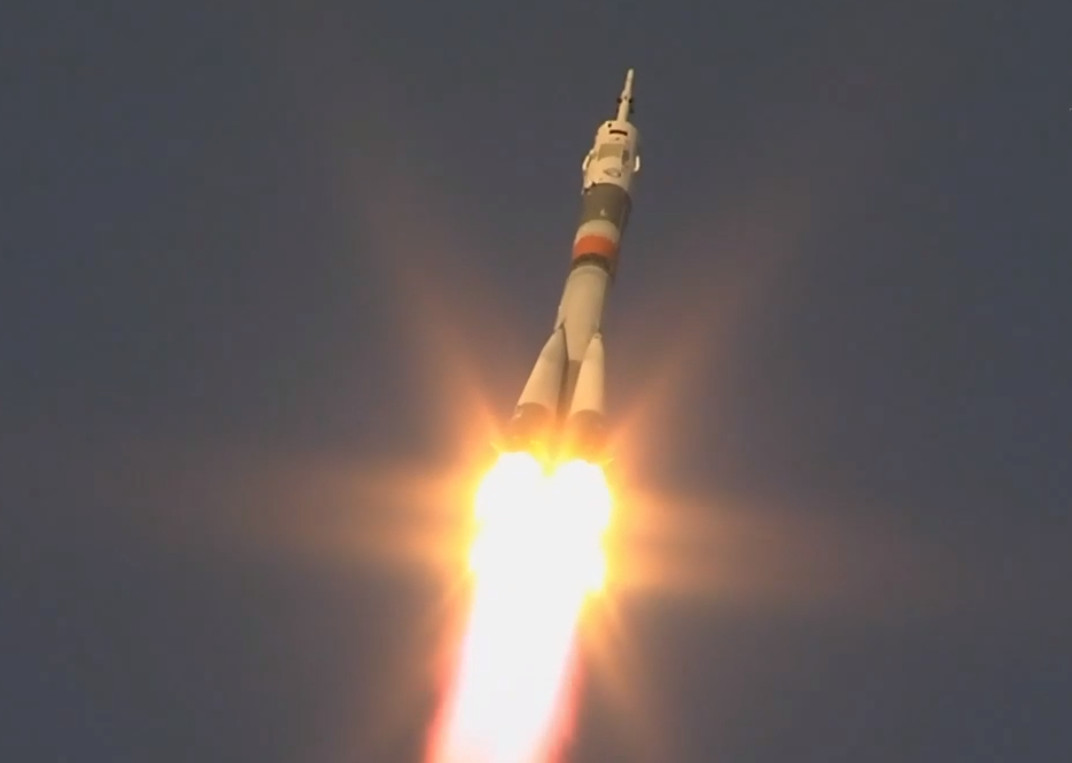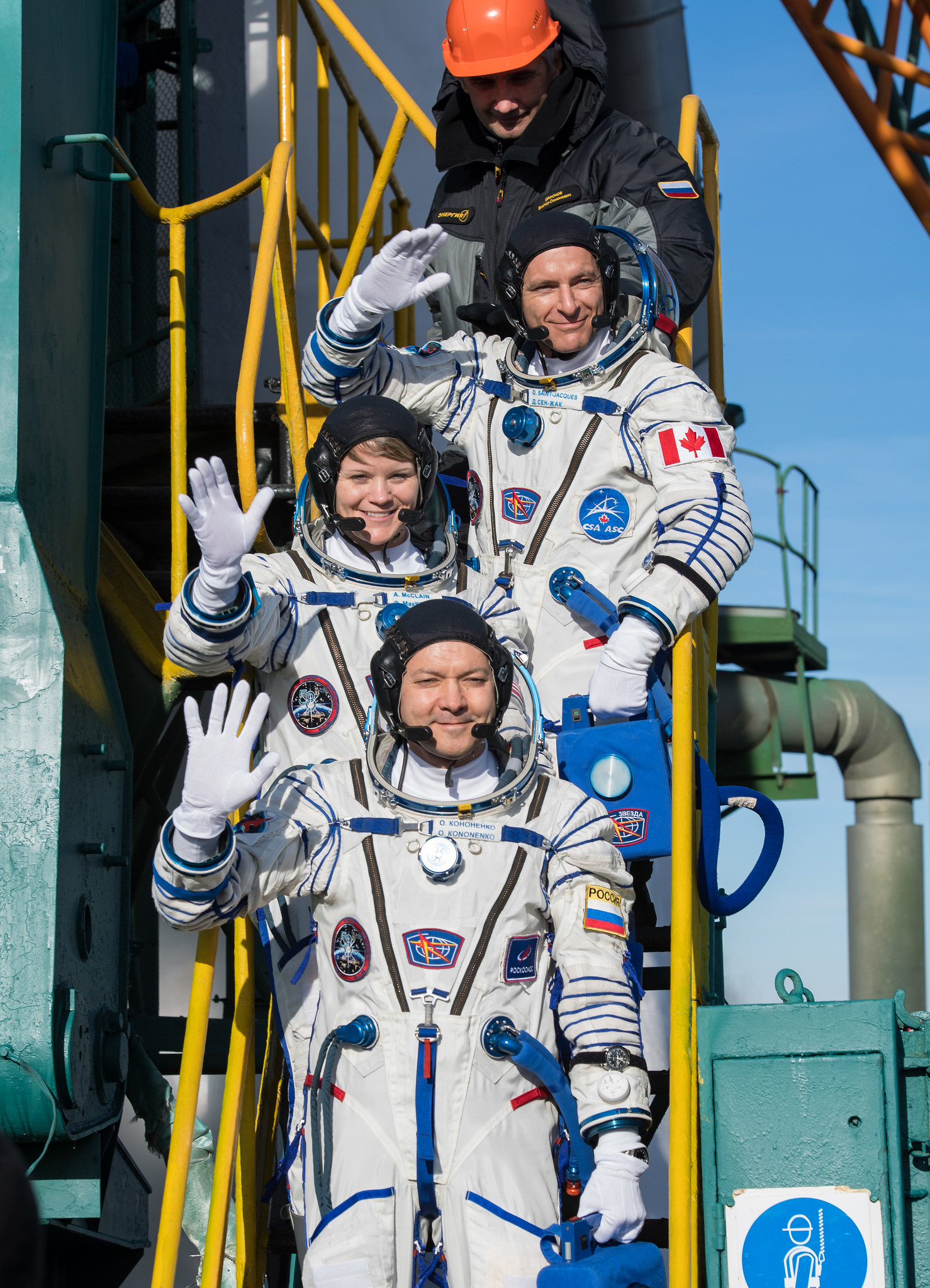Liftoff! Russia Launches 1st Crewed Soyuz Rocket to Space Station Since Dramatic Abort
BAIKONUR COSMODROME, Kazakhstan – With a roar that pierced the air of the subfreezing desert here, a Russian Soyuz rocket carrying a new crew for the International Space Station made a flawless sunset launch into orbit today (Dec. 3). It was the first crewed Soyuz launch since a dramatic abort in October forced an emergency landing for two space travelers.
Hundreds of spectators and media representatives gathered on cold metal stands to watch the launch here at the Baikonur Cosmodrome in Kazakhstan, bundling up cameras and bodies against the bone-chilling cold. But the weather did not dampen the cheers of the crowd as the Soyuz spacecraft — powered by a Soyuz rocket — lifted off from this former Cold War complex carrying three new crewmembers for the station's Expedition 58 crew.
It was a "textbook launch and insertion into orbit," NASA spokesperson Gary Johnson said during launch commentary. "We had a great liftoff today," he added. [See more launch day photos of the Expedition 58 crew]

Riding on board were veteran Russian cosmonaut Oleg Kononenko, who has accumulated more than 533 days in space since 2008 on Expeditions 17, 30/31 and 44/45; and rookie astronauts Anne McClain of NASA and David Saint-Jacques of Canada.
Now, the crew is racing to the space station, a 6-hour journey in total, to catch up to the orbiting complex. The trio is scheduled to dock with the space station at 12:36 p.m. EST (1736 GMT), and the hatch will open at around 2:35 p.m. EST (1935 GMT). Both of those milestones will be broadcast live, with coverage beginning about 50 minutes before the event; you can watch it live on Space.com, courtesy of NASA TV, or on the agency's website.
The arriving astronauts will be greeted by three crewmembers who have been at the space station since June 8: European astronaut Alexander Gerst, NASA astronaut Serena Auñón-Chancellor and Russian cosmonaut Sergey Prokopyev. Gerst was able to see the Soyuz MS-11 spacecraft from the station as the spacecraft launched into orbit, Johnson said. At the time, the space station was flying about 252 miles above northeastern China.
It's been a challenging few months for the crew on board the space station. After a perfect launch on June 6, a tiny air leak on their Soyuz spacecraft was discovered in late August. Although it never posed a threat to the astronauts on board and was quickly plugged, the implications for astronaut safety were troubling, and an investigation was launched. (The leak is in a part of the Soyuz module that does not survive re-entry and it will not interfere with the crew's journey home.)
Get the Space.com Newsletter
Breaking space news, the latest updates on rocket launches, skywatching events and more!
Then, on Oct. 11, as Gerst was filming the space station's view of the next crew launch, something else went wrong. A few minutes after liftoff, a deformed sensor in the Soyuz rocket forced an abort and a quick return to Earth for those two crewmembers. (The astronauts landed unharmed about 30 minutes after the failure.)
For a few weeks, concerns about the safety of the Soyuz system suggested that the space station might need to be abandoned for the first time since 2000. However, Roscosmos concluded its investigation quickly and ended up moving forward the launch of Expedition 58 by three weeks, to give time for the arriving and departing crews to overlap before Gerst's crew departs for Earth on schedule.

With only three crewmembers working on the space station, science experiments are taking second seat to maintenance activities. Saint-Jacques told reporters in October that he also expects he will not have the chance to do a spacewalk, due to safety concerns; the Canadian Space Agency previously said they hoped Saint-Jacques would have the chance to do one.
Today's launch marks the first time a Canadian has flown into space since the wild public-relations success of Chris Hadfield, who commanded the ISS in 2013 and ran a scientifically productive mission while playing guitar, chatting with celebrities and accumulating hundreds of thousands of followers on Twitter. The CSA acknowledged that Hadfield's success was likely unique, but pointed out that Saint-Jacques has communication skills of his own that he can leverage in space —such as an ability to crack jokes on the spot in at least two languages, English and French — he speaks five.
There is a scarcity of Canadian astronauts because the country's contributions to the space station are budgetarily limited, although the robotics the country has produced are crucial to the proper functioning of the space station. At current launch rates, this means Canada gets to send an astronaut to the space station about twice a decade.
But once Kononenko, McClain and Saint-Jacques arrive at the orbiting laboratory, they won't have much leisure time — the space station crew has a packed schedule for the next couple weeks. Tomorrow (Dec. 4), a SpaceX Dragon capsule loaded with tons of supplies will blast off, arriving on Dec. 6. On Dec. 11, Kononenko and his Russian colleague Prokopyev will perform a spacewalk, scheduled to last about 6 hours. And on Dec. 19, Gerst, Auñón-Chancellor and Prokopyev will pack up and head for home, leaving the new crew in their stead.
Follow us on Twitter @Spacedotcom and on Facebook. Original article on Space.com.
Join our Space Forums to keep talking space on the latest missions, night sky and more! And if you have a news tip, correction or comment, let us know at: community@space.com.

Elizabeth Howell (she/her), Ph.D., was a staff writer in the spaceflight channel between 2022 and 2024 specializing in Canadian space news. She was contributing writer for Space.com for 10 years from 2012 to 2024. Elizabeth's reporting includes multiple exclusives with the White House, leading world coverage about a lost-and-found space tomato on the International Space Station, witnessing five human spaceflight launches on two continents, flying parabolic, working inside a spacesuit, and participating in a simulated Mars mission. Her latest book, "Why Am I Taller?" (ECW Press, 2022) is co-written with astronaut Dave Williams.









